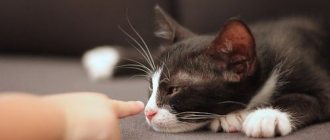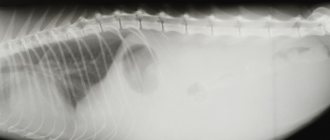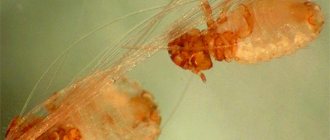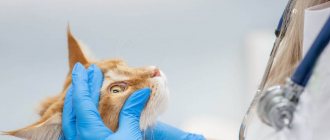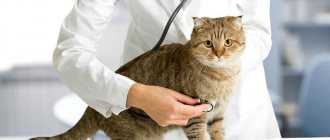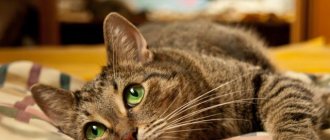Features of the disease
Discharge from the nostrils and eyes is one of the signs of distemper in cats.
Feline distemper, or panleukopenia, is a highly contagious disease. The clinical picture depends on the type of disease, but always manifests itself with fairly clear signs. This is due to the rapid multiplication of the virus in the body, the speed of which largely depends on the state of the immune system. The most vulnerable felines are kittens, pregnant and weakened cats, as well as purebred pets.
The virus that causes distemper in domestic cats is highly resistant to external factors. It can tolerate low and high temperatures; even heating to +60 ˚C can destroy it only after 60 minutes. Disinfectants also cannot destroy pathogenic microorganisms, especially if they are diluted in low concentrations.
Diagnosis of the condition
At the slightest suspicion of distemper, you must immediately contact a veterinary clinic to carry out all tests and immediately begin treatment. The sooner treatment begins, the greater the chance of saving your pet.
The following studies are being carried out:
- Mouth and nose swab;
- Stool analysis;
- Blood test for the number of leukocytes;
Differential diagnosis is also carried out. The diagnosis is made based on history, examination, laboratory and clinical tests.
How can a cat become infected with distemper?
There are several ways a cat can become infected with the distemper virus. In each of them, the source is the biological secretions of an already sick animal or a carrier of infection.
Infection method
Detailed description
Direct contact
A pet can “catch” the disease by directly touching objects that the sick animal has come into contact with. The virus can enter the house and on the owner’s belongings.
Oral route
Distemper infection will also occur if you eat food or drink that contains the infection.
Through the air
If a healthy cat is in the same room as an infected one, then panleukopenia cannot be avoided.
Through bites
Blood-sucking insects are capable of transmitting the feline distemper virus.
In utero
The feline distemper virus is able to cross the placental barrier. In most cases, fetuses die before birth. If the kittens succeed in being born, then in the near future (no more than two days) they still die.
Many owners are interested in whether a cat can get distemper from a dog? No, he can not. The viruses that cause plague in these animals are completely different.
What is panleukopenia
Panleukopenia in cats is a disease caused by the parvovirus Virus panleukopenia feline. The intracellular agent, having entered the animal’s body, begins to rapidly multiply and infect internal tissues.
First of all, parvovirus affects the gastrointestinal tract, causing general intoxication and dehydration of the body, which often leads to the death of the pet. In addition, the causative agent of plague affects the bone marrow, lymphatic system, heart and lungs of a sick animal.
The panleukopenia virus is antigenically related to Parvovirus enteritis canum, which causes parvovirus enteritis or parvovirus in dogs.
The pathogen is capable of maintaining pathogenic activity in the environment from several days to a year. The viability of parvovirus is affected by temperature. At high temperatures, the extracellular agent quickly dies. High humidity and the absence of ultraviolet rays are favorable conditions for the virus, which allow it to remain active for a long period.
How does distemper manifest in cats?
The feline distemper virus can infect almost all organ systems: nervous, respiratory, cardiovascular, and digestive tract. Symptoms of the disease depend on which organs the microorganism has managed to damage, on the capabilities of the cat’s immune defense, as well as on the form of the disease, which can be of three types.
Form of the disease
Peculiarities
Symptoms
Lightning fast
It has a particularly high mortality rate as it develops quickly. It is observed mainly in kittens of the first year of life. The smaller the kitten, the faster it dies. The fulminant form is often manifested by disorders of the nervous and digestive systems.
- Refusal to suck, food, water
- Apathetic state
- Avoiding bright light and sharp sounds (when they occur, it begins to squeak loudly)
- Diarrhea, vomiting
- Tousled fur
- Body tremors, convulsions
- Paralysis
Acute
More common in adult cats. The incubation period ranges from 3 to 10-14 days. The clinical picture is varied and depends on the number of affected organs. Mainly the gastrointestinal tract, respiratory system, and heart are affected. With timely contact with specialists and proper treatment, the pet can recover. If no help is provided to the animal in the next 3-5 days after the onset of symptoms, it will die.
- Apathy
- Temperature rises to 41˚
- Vomit contains blood, mucus, and foam
- Despite being thirsty, the cat refuses to drink water
- Skin spots
- Cough, wheezing
- Discharge from nostrils, eyes
- Tachycardia
- Shortness of breath, mouth breathing
- Sunken eyes, tousled, dull coat
Subacute
It is typical for adult mustachioed individuals and cats that have been vaccinated against distemper. The disease may last for 1-3 weeks.
The same as in the acute form of plague, but in a less pronounced form.
Symptoms
Panleukopenia (feline distemper) is always accompanied by the following symptoms:
- Severe vomiting.
- Reduced activity.
- Vomit.
- Sunken eyes.
- Refusal to eat.
- Dehydration.
- Dry skin.
- Diarrhea.
- Fever (up to 42 degrees Celsius).
Distemper
Cats are generally active animals, and if they recently begin to huddle in corners and lie down, then this is a clear sign of fever. Due to severe cramps, the pet simply stops drinking, and then the first stage of dehydration occurs. After this, the second one comes, and then the mucous membranes of the skin begin to turn blue. If the disease is severely advanced, then you may notice traces of blood in the fecal matter.
Therapeutic measures
At the first symptoms of distemper, we recommend immediately contacting a veterinarian
Treatment of distemper in cats includes several tasks: destroy the virus, eliminate intoxication, prevent secondary infection, increase immunity, and so on. To combat the virus, drugs such as Vitafel, Fosprenil, Enterostat are used. The administration regimen is prescribed by the veterinarian.
Various drugs are used as a symptomatic treatment for distemper in cats.
- Sodium chloride. The distemper virus causes severe dehydration and intoxication. The body cannot cope with toxins on its own. Intravenous administration of a chloride solution helps restore the balance of water, salts, and minerals.
- As a rule, distemper in cats is accompanied by a secondary infection. To eliminate it, the veterinarian will prescribe antibacterial agents.
- Diuretic fees. To quickly cope with toxic metabolic products and remove them from tissues and the body, decoctions of diuretic herbs and herbs are used. In frequent small portions, you can give your cat a decoction of lingonberries, horsetail, bearberry leaf and others.
- If there is no vomiting, it is recommended to use Regidron or Ringer's solution to normalize the water-mineral balance. The daily amount of solution is calculated based on the ratio of 5 tbsp. l. liquid per 1 kg of animal weight. You can add glucose solution and sodium bicarbonate to the diluted drugs (the proportions must be checked with your veterinarian).
- For pain and spasms in the digestive tract, taking antispasmodics, for example, No-shpa, is indicated.
- Catozal will help strengthen metabolic processes, improve immunity, and stimulate the body to recover. It must be administered within 7 days.
- The treatment complex also includes vitamin supplements, especially antioxidants A and C, and B vitamins. It is advisable to combine their intake with drugs containing iron, for example, Ferrodextran.
Establishing diagnosis
Panleukopenia is a very dangerous disease, so the main thing to do when the first symptoms appear is to show the animal to a veterinarian. To make a diagnosis, attending physicians first examine and listen to four-legged patients, and then ask the owners about when the first symptoms of distemper appeared in cats.
After analyzing the data obtained, the animals are prescribed a set of studies.
Diagnostic methods
To understand whether a cat has the causative agent of panleukopenia in its body, blood and feces are taken from it for examination. To detect the virus, the following diagnostic methods are used:
- clinical blood test;
- examination of feces using the PCR method;
- blood chemistry;
- Ultrasound of the abdominal cavity;
- smear of discharge from the eye.
On a note. PCR testing may give a positive result in recently vaccinated animals. Therefore, be sure to check how long ago the cat was vaccinated.
Differential diagnoses
For effective treatment of distemper in cats, it is important to make a correct diagnosis. Since panleukopenia has symptoms characteristic of many diseases, the first step is to exclude:
- feline immunodeficiency virus;
- acute toxoplasmosis;
- intestinal perforation;
- pancreatitis;
- intoxication of the body;
- leukemia.
Home care
Proper care at home for a cat with distemper increases the likelihood of a successful recovery. If possible, it is better to give injections by calling a doctor at home, since any stress can negatively affect the animal’s condition. If you have to visit the clinic every day, then for transportation it is better to build a basket yourself (for example, from a cardboard box), so that you can burn it later.
The room where the cat is located should be warm and dry, without draft wind. Since the virus also affects the nervous system, you need to provide your pet with peace and shade with bright light.
You can drink both plain water (boiled) and decoctions of medicinal herbs. Their choice should be previously agreed with your veterinarian, because some medications and plant extracts may be incompatible. You need to feed your pet little by little, at the beginning of treatment - only broths, gradually adding porridge and chopped meat to them. It is recommended to follow a diet until complete recovery.
In agreement with the doctor, it is allowed to give the cat enemas. They may include herbal preparations, decoctions, and antiseptics. The tray and bowls should be placed next to the animal, and the bedding should be changed daily. Washing your pet while sick is not recommended.
Treatment and prognosis
Distemper in cats must be treated comprehensively using etiotropic agents to destroy the virus and drugs that relieve the main symptoms. Typically, to treat panleukopenia, animals are prescribed the following drugs:
- Fosprenil. An antiviral drug is used to destroy pathogens and is administered intramuscularly for 14 days. In the early stages of the disease, it is used daily 4 times a day in a dosage of 0.2 ml of solution for kittens weighing up to 1 kg and 0.5 ml for cats weighing 1-5 kg. Gradually the number of injections is reduced to 1 time per day.
- Ringer, Regidron. Rehydrating drugs to eliminate signs of dehydration and normalize electrolyte balance. They are diluted with glucose and given to cats at the rate of 50 ml per 1 kg of weight.
- No-shpa, Dibazol. Painkillers that effectively relieve pain and relieve spasms. Used in the form of injections in strict accordance with the instructions of the veterinarian.
- Ticarcillin, Cephalosporin, Ampicillin. Antibiotics that destroy secondary bacterial infections. Used in injections strictly as prescribed by a doctor.
- Metaclopromide, Ondanseron, Maropitant are antiemetics. They are used in the form of injections strictly as prescribed by a veterinarian.
- Catozal. The metabolic stimulant normalizes metabolism and is used only on the recommendation of a specialist.
In addition to medications, treating a cat at home should include the use of iron-containing medications and vitamin complexes that contain folic acid.
Important! Although experts strongly discourage treating cats with vodka, there are cases where animals survived after such therapy. True, it cannot be said that the reason for the recovery was the use of alcohol, and not the strong immunity of the pets.
To speed up the healing process, the animal needs to be provided with proper care:
- Disinfecting surfaces using an ultraviolet lamp and sodium hypochlorite solution. The area where the sick cat is located should be disinfected. The animal's bedding and bowls should be disinfected with a soda solution prepared in a ratio of 1:20.
- Creating a favorable atmosphere. A cat suffering from distemper needs complete peace and positive emotions.
- Avoid contact with other animals. Distemper in cats is transmitted very quickly. Therefore, an infected pet is protected from contact with healthy companions.
- Maintaining cleanliness. All feces from a sick animal must be removed immediately. It is recommended that the room where the infected cat is kept is regularly ventilated and wet cleaned.
- Periodic eye cleansing. To do this, it is recommended to use clean gauze moistened with a special solution.
- Dieting. While the cat continues to be sick, she needs a special menu with low carbohydrate content and increased protein. To do this, it is recommended to introduce low-fat fermented milk products, boiled fish and beef into the animal’s diet.
Panleukopenia is characterized by high mortality. According to statistics, in 92% of cases it ends in the death of animals. Distemper is especially dangerous in kittens, with mortality rates reaching almost 100%.
Can other animals or humans become infected with feline distemper?
Is a pet with panleukopenia dangerous to others? Cats after distemper are carriers of the virus for 4-5 months and can become its source, but only a feline can become infected. The mustachioed friend poses no danger to surrounding people and pets.
The virus, which is carried by a recovered cat, is released into the external environment with biological fluids, so throughout the entire period of carriage the pet should not be allowed to leave the house. The cat itself acquires immunity to the plague for a long period, sometimes until the end of its life.
Signs of food poisoning and possible complications
Despite the fact that food poisoning occurs due to various reasons, its manifestations at first are always the same, and the symptoms are similar.
The main feature of any poisoning is the speed with which it occurs. Everything happens very rapidly and quickly - within a few hours or in the next 24 hours the body signals a problem1.
The human body is a self-regulating system and therefore tries to get rid of pathogens in any way. This may include general malaise, diarrhea and abdominal pain3:
- Abdominal pain varies in nature, but is often sharp and quite severe. The intestines react to most toxins and bacteria with a spasm.
- Intoxication of the body - headache, weakness, muscle pain and joint aches.
- Diarrhea is also a striking symptom of food poisoning, manifesting itself in almost every case.
In case of severe poisoning, other symptoms may be added - nausea, vomiting and fever3:
- Nausea is one of the clearest examples of how the body tries to resist a food infection and eliminate bacteria. Nausea may be accompanied by belching and a feeling of heaviness in the stomach.
- Vomiting is another of the body’s defense mechanisms against infectious agents. In case of severe and progressive poisoning, vomiting must be controlled, otherwise severe dehydration may occur.
- Dehydration syndrome. Conditions for such a symptom would be active vomiting or diarrhea. The human body loses a huge amount of fluid in a short period of time, which can be expressed by severe thirst and dizziness, up to loss of consciousness. Dehydration is especially dangerous in children, who, with severe poisoning, instantly lose all water reserves in the body.
- Increased body temperature. The body reacts to any attack in a similar way. Food poisoning is no exception, the body tries to fight, which is manifested by an increase in temperature from 37.5º C to 40.0º C - it all depends on the specific type of virus or bacteria.
Prevention of plague
Don’t forget about vaccination, and the risk of getting distemper will be minimized
The most effective preventative measure for feline distemper is vaccination. Since there are currently enough vaccines, the doctor chooses at his own discretion. The following drugs are popular: Nobivak, Multifel, Feleniffa.
Kittens are first vaccinated at 1.5-2 months, and after 3-4 weeks they are revaccinated. Subsequently, the vaccine is administered once a year.
You can prevent a deadly disease by not letting newborn kittens go outside, preventing your pets from escaping and interacting with unfamiliar family members. In addition, it is necessary to monitor the immune system of your mustachioed friend, providing the cat with adequate nutrition and vitamins.
How is it transmitted?
The sources of this deadly disease are sick cats and virus carriers. Parvovirus is shed in stool (feces, urine) or saliva. There are several ways of contracting panleukopenia:
- During oral contact. The virus can enter the oral cavity along with saliva. More often this happens when drinking water or eating food infected with viral particles from a virus carrier or a sick animal.
- By airborne droplets. A healthy individual becomes ill with panleukopenia while in close proximity to a patient.
- By contact method. Infection occurs through personal belongings, clothing or shoes of the owner of a furry animal who has been in contact with a virus-carrying cat. In addition, parvovirus survives on litter trays, harnesses, bowls and toys for up to a year.
- In utero. The virus easily passes through the placental barrier and penetrates the fetus. Kittens infected at an early stage of pregnancy die (decompose inside, mummify) before birth or die 1-2 days after birth. Babies infected at a late stage often have congenital underdevelopment of the cerebellum.
- Transmissible method - when the causative agent of panleukopenia is carried by blood-sucking parasites - ticks, fleas, bedbugs.
Almost all representatives of the cat family can become infected with parvovirus: tigers, leopards, cheetahs. Among domestic animals, distemper is a widespread disease, to which unvaccinated kittens under one year of age and cats older than 6-8 years are more susceptible: young animals are predisposed to the disease due to undeveloped immunity, and older pets with age lose the ability to resist various viruses, because the immune properties of the body become weaker.
Pregnant cats and small kittens are also at risk of contracting panleukopenia. The chances of contracting plague increase in babies over two weeks of age. This is explained by the fact that the mother’s immunity weakens, and the baby’s own immune system is not enough to resist such a dangerous virus. If we consider breed predisposition, parvovirus is most dangerous for British representatives, Maine Coons, Siamese and Persian cats.
Is it dangerous for humans?
Panleukopenia is not dangerous to humans. They can only act as carriers of parvovirus on their outerwear, shoes and other things. Owners of several pets should be careful: if one cat has become infected with infectious enteritis, it must be isolated from a healthy cat and strictly quarantined. It is noteworthy that dogs are not afraid of the virus. Although they can get distemper, it can be caused by a completely different type of parvovirus.

